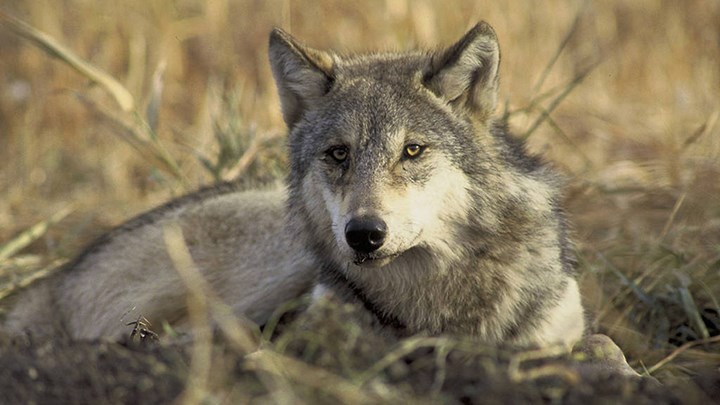
by Brian McCombie - Friday, March 15, 2019

It’s official. The U.S. Department of the Interior (DOI) has directed the U.S. Fish and Wildlife Service (USFWS) to begin the legal process required to remove gray wolves (Canis lupus) in the lower 48 states from protection under the Endangered Species Act (ESA). (This does not apply to Mexican gray wolves or red wolves.)
As USFWS noted in a press release, “The gray wolf, an iconic species of the American West, had all but disappeared from landscape in the lower 48 states by the early 20th century. Now it roams free in nine states and is stable and healthy throughout its current range. This constitutes one of the greatest comebacks for an animal in U.S. conservation history.”
Thanks to the partnerships involving states, tribes, conservation organizations and private landowners galvanized under the ESA, the Service explains it is now able to propose turning management of all gray wolves back to the states and tribes that have been so central to the species’ recovery.
“The facts are clear and indisputable, the gray wolf no longer meets the definition of a threatened or endangered species,” said DOI Acting Secretary David Bernhardt. “Today the wolf is thriving on its vast range and it is reasonable to conclude it will continue to do so in the future. Today’s action puts us one step closer to transitioning the extraordinary effort that we have invested in gray wolf recovery to other species who actually need the protections of the Endangered Species Act, leaving the states to carry on the legacy of wolf conservation.”
That’s the good news. The bad? If recent history is any indication, the delisting process will drag its way through the courts as the animal rights extremists and anti-hunters will, no doubt, continue their quest to keep the gray wolf on the ESA, seemingly forever. These groups have fought every effort to let the states manage their growing wolf populations. And, frankly, the groups have been quite successful at blocking attempts to return wolf management to the states.
As the NRA-ILA noted in 2017, one key reason animal rights and anti-hunting groups so vehemently oppose delisting the wolves is because protecting the wolves assists their war on hunting. “Anti-hunting groups, including the Humane Society of the United States ... know that excessive wolf predation of elk, deer and moose reduces hunting opportunities in the American Northwest. Fewer opportunities to hunt mean fewer hunters, which is key to their long-term goal of eradicating America’s outdoor sporting traditions.”
As these groups pushed their legal attempts to keep wolves listed, the NRA, Safari Club International and other pro-hunting organizations gained intervenor status in these suits to help vindicate the scientific management of the wolves through state fish and wildlife agencies.
“For years,” the NRA-ILA article explained, “the NRA has been working to ensure that sound wildlife management practices implemented by the states, and not federal politics, govern the control of wolf populations in the United States.”
The science and the ESA are clearly on the side of delisting the gray wolf. According to the USFWS announcement, “The measure for listing a species under the ESA is whether wolves are in danger of extinction or at risk of becoming so in the foreseeable future, throughout all or a significant portion of their current range. The ESA does not require wolves to be present throughout all of their former range or for populations to be at historical levels for delisting to occur.”
It also notes that peer-reviewed studies on factors such as habitat and prey availability, gray wolf adaptability (including to changing climate conditions), recovery activities and post-delisting regulatory mechanisms, and predictions about how these may affect the wolves in the future are consistent in guiding the Service’s decision to delist. "By any scientific measure, wolves no longer meet the ESA’s standard for protection."
The USFWS proposal to delist the gray wolf throughout the conterminous United States is open for public comment in the Federal Register from March 15 until May 14, 2019. The proposed delisting rule is available for public inspection on the Federal Register’s website. Comments are set for 60 days and will be posted on Regulations.gov. Requests for public hearings are set for 45 days. Additional information on the proposed rule and instructions on how to comment may be found at USFWS.
NRA Institute for Legislative Action (NRA-ILA) Associate Litigation Counsel Michael Jean offered an estimate on what the timeline might look like. “It took the USFWS 15 months to sort through grizzly bear comments during that species’ delisting process before releasing a Final Rule. And add a couple years of litigation on to the end of that.”
NRA-ILA and the NRA Hunters’ Leadership Forum will continue to follow this important issue, one that at its core is about the right of states to manage their wildlife under the extremely successful North American Model of Wildlife Conservation.
■ ■ ■
About the Author: Brian McCombie is a field editor and editorial contributor for the NRA's American Hunter and this website, NRAHLF.org. He writes about firearms and gear for the NRA's Shooting Illustrated website, as well handling public relations and marketing for companies and manufacturers in the shooting sports industry. He is a member of the National Rifle Association and the National Shooting Sports Foundation. Brian likes hunting hogs, shooting 1911s chambered in 10 mm and .45 ACP, watching the Chicago Bears and relaxing with Squinchy, his orange tabby cat.
Follow NRA Hunters' Leadership Forum on Twitter @HuntersLead.
E-mail your comments/questions about this site to:
[email protected]
